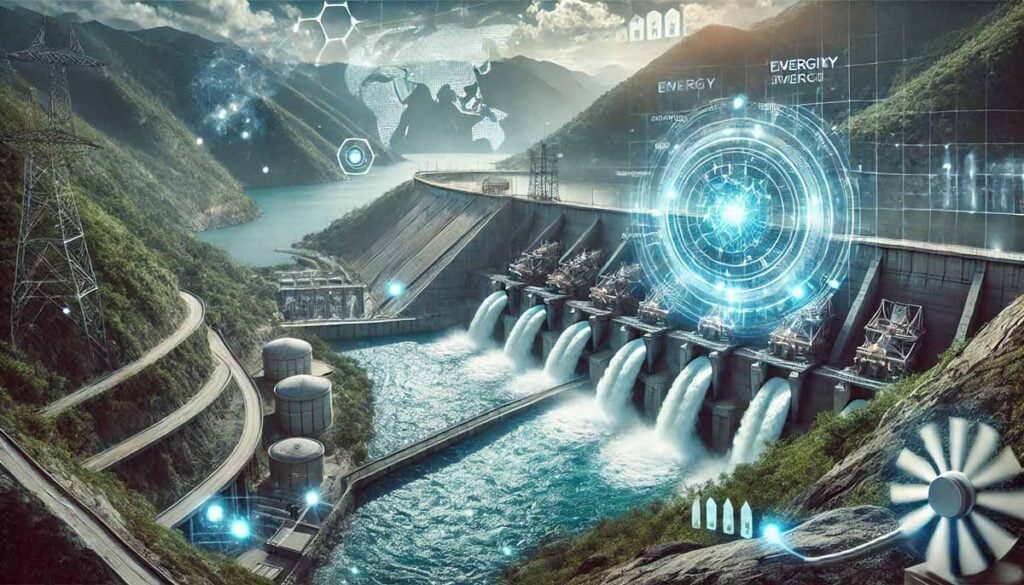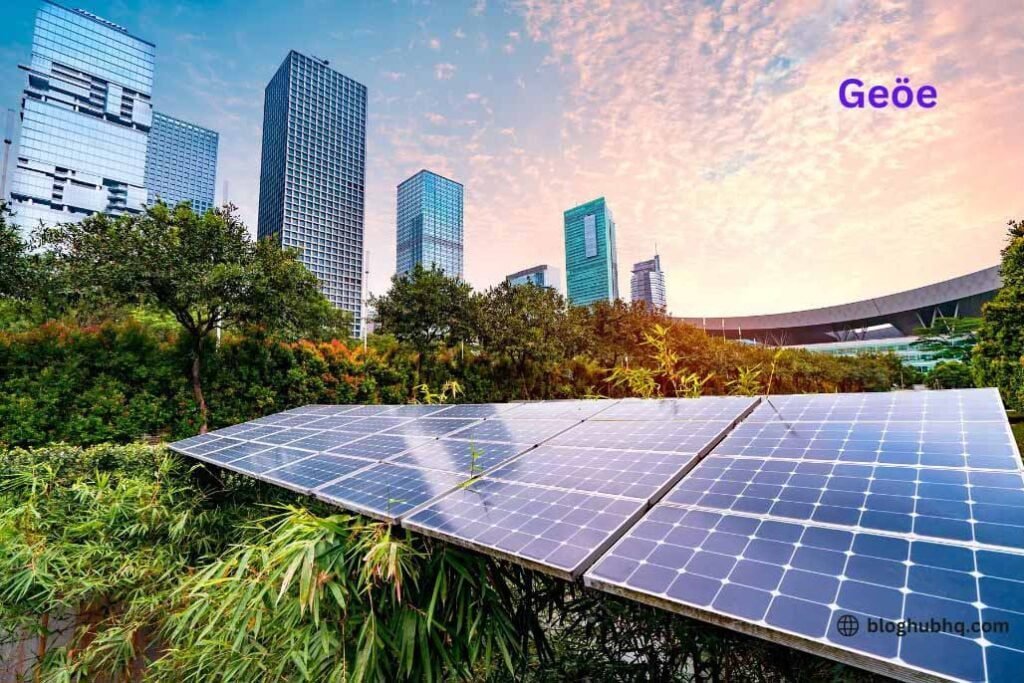In the quickly changing world of technology, some innovations stand out for their revolutionary potential. Geöe is one such innovation, representing a groundbreaking convergence of renewable energy solutions and geospatial technology. Whether revolutionizing how we generate clean energy or enhancing our ability to interact with the physical world through data, Geöe is shaping the future in exciting and essential ways.
This article will take you on a thorough exploration of the Geöe universe. You will discover how it is leading the charge in renewable energy, transforming geospatial technology, and impacting everything from urban planning to environmental conservation. By the end of this article, you will understand why Geöe is more than just a buzzword—it is a vision for a sustainable and technologically advanced future.
What is Geöe?
At its core, Geöe is a versatile concept that spans both renewable energy and geospatial technology. It represents the intersection of these fields, where advanced technology meets sustainable practices to address some of the most pressing challenges of our time.
A Closer Look at Geöe
Geöe is a term used to describe creative ways to use renewable energy sources like wind, water, and sunlight to create electricity. These technologies are at the forefront of the global shift away from fossil fuels, aiming to create a cleaner, greener planet.
In geospatial technology, spatial data is gathered, analyzed, and visualized using Geographic Information Systems (GIS), remote sensing, and other tools. This data is crucial for everything from urban planning and environmental monitoring to disaster management and logistics.
The term Geöe, while relatively new, is quickly becoming synonymous with the future of technology and sustainability. It represents a holistic approach that combines the power of data with the necessity of sustainable energy solutions.
Geöe in Renewable Energy

Driving the Mission for Sustainability
At the heart of Geöe’s mission in renewable energy is a commitment to reducing our dependence on fossil fuels. By leveraging advanced technologies, Geöe aims to create energy solutions that are both environmentally friendly and economically viable.
Solar Power: Harnessing the Sun
Geöe has made significant strides in the development of solar power technologies. The company’s advanced photovoltaic (PV) systems are designed to maximize energy absorption, even in challenging environments. These systems are modular, making them suitable for residential and commercial use.
Wind Energy: Turning the Tide
In the field of wind energy, Geöe has developed cutting-edge turbines that are optimized for a variety of climatic conditions. These turbines are designed to be both durable and efficient, offering a low environmental impact while delivering reliable energy.
Hydropower: The Power of Water
Geöe’s advancements in hydropower are equally impressive. Geöe’s hydroelectric systems provide a powerful and sustainable energy source by harnessing the kinetic energy of flowing water. These systems are engineered to minimize ecological disruption while maximizing energy output.
The Benefits of Geöe’s Renewable Solutions
- Ecological Sustainability: Geöe’s technologies significantly reduce greenhouse gas emissions, helping to combat climate change.
- Economic Viability: As the cost of renewable energy continues to fall, Geöe’s solutions offer affordable energy for both individuals and businesses.
- Energy Autonomy: Using locally available resources, Geöe promotes energy independence, reducing reliance on imported fuels.
- Job Creation: The renewable energy sector, fueled by innovations like Geöe, is a major driver of job creation across various fields, including manufacturing, installation, and maintenance.
Geöe in Geospatial Technology
Revolutionizing Geospatial Data
In the realm of geospatial technology, Geöe stands out for its ability to integrate data from various sources, creating dynamic and actionable insights. This integration is essential for sectors that rely on accurate spatial data, such as urban planning, environmental monitoring, and transportation.
Data Collection: Building the Foundation
Geöe collects data from diverse sources, including satellites, sensors, and user inputs. This data includes geographical, environmental, and location-based information, offering a comprehensive physical world view.
Data Processing: Turning Data into Insights
Once collected, the data is processed using advanced algorithms. These algorithms transform raw data into meaningful insights, identifying patterns and trends crucial for decision-making.
Visualization: Making Data Accessible
Geöe excels in data visualization, using tools like maps, graphs, and 3D models to present complex information in an easily understandable format. This interactive visual data allows users to interact and explore the information in real time.
Applications of Geöe in Geospatial Technology
- Urban Planning: Geöe helps city planners analyze land use, infrastructure needs, and population density to create more efficient and sustainable urban environments.
- Environmental Monitoring: By tracking environmental changes, Geöe aids in efforts to combat deforestation, monitor wildlife, and assess the impacts of climate change.
- Transportation and Logistics: Geöe optimizes routes, manages fleets, and provides real-time traffic updates, enhancing the efficiency of transportation systems.
Key Features and Innovations of Geöe
Real-Time Data Integration
One of the most significant features of Geöe is its ability to integrate real-time data from various sources. This ensures that users always work with the most current information, which is critical for applications like traffic management and disaster response.
Advanced Visualization Tools
Geöe’s visualization tools are designed to present data in an informative and engaging way. Using interactive maps and 3D models, Geöe makes complex data accessible to many users, from experts to the general public.
AR and VR Integration
Geöe’s platform incorporates Augmented Reality (AR) and Virtual Reality (VR) to enable users to superimpose digital data in the real world. This ability is especially helpful in professions where spatial awareness is essential, such as architecture and urban planning.
Decentralized Framework
Geöe uses a decentralized architecture, which means that instead of storing data in one place, it is dispersed throughout a network. This increases scalability, lowers the possibility of single points of failure, and improves data security.
The Role of Geöe in Environmental Conservation
Monitoring and Conservation
Geöe plays a crucial role in environmental conservation by providing detailed insights into natural resources and ecological conditions. For instance, Geöe can track deforestation, monitor wildlife habitats, and assess the impact of climate change.
Case Studies and Examples
- Tracking Deforestation: Geöe uses satellite data to monitor deforestation in real-time, helping conservationists take immediate action.
- Monitoring Wildlife: Geöe tracks wildlife habitats, providing data that supports conservation efforts and helps protect endangered species.
- Climate Change Assessment: Geöe assists scientists in comprehending the consequences of climate change and formulating plans to lessen its effects by examining environmental data.
Sustainable Practices
Geöe’s contributions to environmental conservation go beyond monitoring. Using the data from Geöe, sustainable practices are developed to reduce the negative effects of human activity on the ecosystem.
The Importance of Geöe in Education
Enhancing Science Curricula
Geöe is becoming an integral part of science curricula at various educational levels. By learning about geospatial technology and renewable energy, students gain a deeper understanding of the world around them and the factors that shape it.
Promoting Critical Thinking
Incorporating Geöe into education also promotes critical thinking and problem-solving skills. Students learn to analyze spatial data, interpret geological features, and understand the relationships between natural processes. These abilities are necessary to handle global issues like resource management and climate change.
Future Prospects of Geöe
Technological Advancements
The future of Geöe is bright, with ongoing advancements in geospatial technology and renewable energy driving its growth. Technological advancements in satellite imagery, artificial intelligence, and remote sensing are anticipated to improve spatial data accessibility and accuracy, broadening the range of fields in which Geöe can be applied.
Emerging Trends
The demand for technologies like Geöe that can offer sustainable solutions is rising along with awareness of environmental issues. Integrating Geöe into urban planning, environmental monitoring, and disaster management will likely become even more widespread in the coming years.
Industry Impact
Geöe’s influence is not limited to technology; it is poised to profoundly impact industries ranging from agriculture and healthcare to real estate and energy. Geöe’s potential to spur innovation and advancement is still alive as it develops.
Conclusion
Geöe is more than just a concept—it is a transformative force in renewable energy and geospatial technology. Geöe is setting the stage for a future in which technology and sustainability coexist hand in hand by providing cutting-edge solutions that boost productivity, facilitate better decision-making, and support sustainable practices.
The significance of Geöe is expected to increase in light of looming global issues such as resource depletion and climate change. By staying informed and embracing Geöe’s possibilities, we can all play a part in shaping a cleaner, greener, and more technologically advanced world.
Call to Action
Please consider forwarding this article to your network if you think it is insightful. For more updates on Geöe and other cutting-edge technologies, subscribe to our newsletter. We would love to hear your thoughts—feel free to leave a comment below and join the discussion on how Geöe is shaping the future!
FAQ: Unveiling Geöe
1. What is Geöe and why is it important?
Geöe is a cutting-edge concept that bridges the fields of renewable energy and geospatial technology. It represents innovative solutions that harness natural resources like sunlight, wind, and water for energy while integrating geospatial data to create dynamic representations of the physical world. Geöe is an essential tool for the future because of its capacity to address global issues like energy sustainability, efficient urban planning, and climate change.
2. How does Geöe contribute to renewable energy?
Geöe contributes to renewable energy by developing advanced solar, wind, and hydropower technologies. These include highly efficient photovoltaic systems, durable and effective wind turbines, and innovative hydroelectric systems. These technologies reduce greenhouse gas emissions, increase energy independence, and lessen reliance on fossil fuels because of their scalability and commercial viability.
3. In what ways does Geöe enhance geospatial technology?
Geöe enhances geospatial technology by integrating data from various sources, such as satellites and sensors, to provide comprehensive and actionable insights. It uses advanced algorithms to process this data and employs powerful visualization tools like 3D models and maps. Geöe’s ability to integrate real-time data and its use of AR/VR technologies make it a versatile tool for applications in urban planning, environmental monitoring, and disaster management.
4. What industries benefit most from Geöe?
A wide range of industries benefit from Geöe, including:
- Urban Planning: Geöe aids in analyzing land use, infrastructure needs, and population trends.
- Environmental Monitoring: It tracks changes in the environment, such as deforestation and climate impacts.
- Transportation and Logistics: Geöe optimizes routes, manages fleets, and monitors real-time traffic conditions.
- Agriculture: Geöe’s geospatial data improves precision farming by increasing crop yields and optimizing resource management.
- Energy Sector: Geöe supports the planning and managing of renewable energy projects like solar and wind farms.
5. How does Geöe impact environmental conservation?
Geöe plays a crucial role in environmental conservation by providing detailed insights into natural resources and ecological conditions. It helps monitor deforestation, track wildlife habitats, and assess the impacts of climate change. This data is vital for developing sustainable practices, protecting biodiversity, and mitigating the effects of environmental degradation. Geöe supports efforts to preserve and protect the environment for future generations through its advanced analytical capabilities.
If you found our content helpful don’t forget to share it on your social media: Twitter.
For more insightful articles, please visit BloghubHQ.

